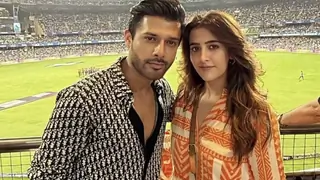Sound of music Thiruvaiyaru, on the banks of the meandering Cauvery, is a magnet for musicians, says A.J. Philip who took part in the 159th aradhana at the samadhi of Thyagaraja
| 
The samadhi of Thyagaraja
|
FROM Chennai to Tirupati to Thanjavur by road, Tamil Nadu was unusually green. The drive was a little bumpy as the heavy rains this year had washed asphalt off the roads. Rivers and rivulets, streams and springs and dams and culverts were all full and there was no shortage of water anywhere in the area, called the rice bowl of the South.
Thanjavur was the seat of power of the Cholas, whose dynasty held sway for a continuous period of about 430 years, i.e., from the 9th to the 13th centuries. It was the most creative period in the history of southern India when art, religion and literature reached heights of excellence, never reached again in succeeding ages.
A colleague in Ludhiana was bowled over by a photograph of the main temple at Thanjavur, known as Rajarajesvaram, he received by e-mail. If a mere photograph could impact him so much, imagine how he would have felt if he had visited the temple, whose ingenious layout, majestic gopurams (towers), exquisite carvings and beautiful idols would simply take one's breath away.

Famous and not-so-famous singers at Thiruvaiyaru |
But Thanjavur was just a port of call. The real destination was Thiruvaiyaru, 13 km from the district headquarters, famous the world over for the Thyagaraja Mahotsavam, held there every year to pay tributes to one of the greatest composers of the world. Thyagaraja was one among the Carnatic music trinity, the other two being Shyama Sastrigal and Muthuswamy Dikshithar.
Ever since I accompanied my father to a Carnatic concert by the late Chembai Vaidynatha Bhagawathar, whose blessing playback singer Yesudas considers the greatest gift he ever received, it was a cherished desire to attend the music festival. Chembai was over 80 when I heard him but his voice was as resonant and powerful as that of a musician one-fourth his age.
Chembai seldom missed the Mahotsavam; there is a photograph of him singing at Thiruvaiyaru still etched in my memory. Every musician in the South considers taking part in the festival as the ultimate tribute to the saint-composer.
We drove down leisurely to Thiruvaiyaru to savour the beauty of the countryside where palm trees stood cheek by jowl with coconut trees. It was difficult for my son to believe that it was on palm leaves that my nursery teacher, Asan as we respectfully called him, wrote the alphabets for me to learn. Those days, a student's ability was measured by the number of leaves he got– the more the better.
One hour later we reached Thiruvaiyaru. The town is situated on the banks of the Kaveri, notorious for the Tamil Nadu-Karnataka row over its waters. As we crossed the river, flowing full, we could hear from the loudspeakers the mellifluous kirtan, Jagadhananda Karaka, the first of the Pancharathna Kritis (five jewels of his renderings) sung in chorus.
From the bridge, the driver showed us the samadhi of Thyagaraja. Soon we were at the huge pandal (a thatched shed), overflowing with people. There was not an inch of empty space anywhere inside. Over a thousand singers, young and old, men and women, professionals and amateurs were sitting on the floor shoulder to shoulder and singing in chorus the most famous compositions of Thyagaraja.
However hard I tried to convince a police officer to allow me inside, he would not budge. The VIP pass I flashed evoked only a derisive laughter from the officer for whom The Tribune sounded Greek. "Here everybody has a VIP pass to show off. What can I do?" He was not at fault as almost everyone trying to get in was clutching at the VIP pass liberally issued by the Sri Thyagabrahma Mahotsava Sabha, headed by G.R. Moopanar, which organises the festival.
Thyagaraja, who spent his lifetime composing songs and chanted Rama nama 96 crore times, never considered anybody a VIP. Or, to put it differently, he considered everybody a VIP. In fact, as the story goes, King Sarabhoji II invited him to sing before him and offered him the position of the court singer with all the attendant benefits but he declined the royal offer in the true spirit of his own name which means the 'Prince of Renunciation'.
Thyagaraja expressed his unwillingness politely through the kriti Nidhi Chaala Sukhama to convey that material acquisition alone was not enough for peace. The wise ruler did not consider his response an offence. Where the "VIP pass" failed, my wife's persuasion succeeded. Finally, the officer allowed me to go inside and click to my heartcontent if I could find an empty spot to stand.
I made a hasty retreat when I found the police manhandling and throwing out from the pandal a photographer from the Indian Express stable. Later, I met him to know that he made the mistake of standing in front of the better half of the Superintendent of Police and blocking her view.
I wondered how Thyagaraja, who was never tempted by wealth, pomp and power and sought comfort and peace at the lotus feet of Rama would have reacted to the brute use of force in the precincts of his own samadhi. The renderings continued with the second of the pancharatna kritis, Dudukugala Netra unmindful of the little violence that just occurred. Almost everyone had the text of the kritis in one of the scripts—Tamil, Telugu, Malayalam, Kannada and Roman. It was a pleasant surprise for me to find two young men standing beside me holding the kritis in Malayalam script. They are "friends" who had come all the way from Guruvayur in Kerala to take part in the aradhana which is the most sacred event in the five-day festival. One of them, Ravi, a music teacher, prompted me to sing at least a line or two. As I sang, I was overwhelmed by the thought that for a few seconds I had become part of a chorus that included, among others, Kunnakudi Vaidyanathan, Sudha Ragunathan, Unnikrishnan, Sirkali Siv Chidambaram, Haridwarmangalam A.K. Palanivel and the Bombay sisters.
It was unlikely that Thyagaraja would have minded my intrusive voice, as nadopasana which was dear to the saint was nothing but a surrender of the musicians at the altar of music. After a pause, the rendering of the third kriti, Sadhinchene began. This kirtan, I am told, personifies all the living creatures in the universe as women. "Simply because all women (creatures) call you simultaneously, should you not heed my plaint?" Thyagaraja laments, indicating that Lord Ranganatha is the sole and eternal asylum for the living beings in the universe.
Thyagaraja did not originally belong to Thiruvaiyaru. In fact, he was not even a Tamil. He was born at Thiruvarur on May 4, 1767, to Ramabrahmam, whose family profession was story telling (Katha Kalashepam). His mother was Seethamma, whose father was a court musician.
His forefathers came from Kurnool district of Andhra Pradesh when the great Vijayanagar Empire fell at the end of the 16th century. They took shelter under the benign rule of the Nayakas and the Maratha kings of Tamil Nadu. Soon after his birth, the family shifted to Thiruvaiyaru where the King of Thanjavur gifted him a house, where he spent most of his life and also attained samadhi. The house was being transformed as a memorial at a cost of Rs 25 lakh. Another memorial was also being planned near the samadhi, with a music library with 72 rooms representing the Melakartha ragas.
The precocious Thyagaraja was initiated into the wondrous world of music by his mother. He learnt everything his guru could teach him within a year. After that, he was on his own, perfecting his technique by immersing himself in the study of musicology from various treatises. He was in his teens when he composed his first song Namo Namo Raghavaya, which he inscribed on the walls of his house. He never looked back. Tradition has it that he once he visited the famous Tirupathi temple. The sanctum sanctorum was closed when he reached there. In sadness, he sang Teratiyagaraadaa. The temple authorities were surprised to see the door opening by itself and the screen falling aside. He instantly composed and sang another song in his happiness at seeing the Lord.
Thyagaraja, for whom Rama was all and everything, is believed to have had a darshan of his Lord with Sita and Hanuman. He had a string of tragedies in his life beginning with the death of his first wife. But his faith remained solid. At the fag end of his life, he took to sanyas christening himself Nadha Premmananther. A month later, he attained siddhi on the Pushya Bahula Panchami day in 1847.
The aradhana organised every year is to commemorate this day. As I left the pandal to visit the samadhi, the singing of the fourth Pancharathna Kriti, Kanakana Ruchira, had begun. It was in this samadhi that his mortal remains were interred. It has an imposing fa'E7ade, a big hall and a portico. Some important Thyagaraja kritis have been etched on marble slabs in the hall. There are also marble idols depicting scenes from the Ramayana.
The last of the Pancharathna kritis, Endharo Mahanubhavulu, was on as I waded my way back to the pandal through the mass of people. The singing had reached a crescendo and it was obvious that the aradhana would soon end. And as the rendering ended, an aarti (flame) was brought from the samadhi, which symbolised the blessing of Thyagaraja for all those who took part in the 159th festival. Earlier in the day, a bhajan procession was taken out from Thyagaraja's house, which culminated in a nadaswaram recital.
Outside the pandal, the singers were being mobbed by their fans for autographs and photographs. They all seemed to be enjoying the well-deserved attention. But inside the pandal, some singers had begun their solo concerts in different corners. Anybody interested in their music could go and sit around them and enjoy their renditions.
The music concerts became a part of aradhana only in 1907. It would continue till midnight. Some of the topmost Carnatic musicians took part in the festival, which began on January 16 and concluded on January 21 this year. As one of the singers told me, it is a humbling but ennobling experience to take part in the aradhana.
A long queue had already formed for a sumptuous pure-vegetarian community lunch served on plantain leaves. I had to abandon the thought of partaking of it as I had to pack into the day a visit to the famous temple at Thanjavur and send a photograph of it to the Ludhiana colleague as promised. But not before visiting the Shiv Mandir at Thiruvaiyaru where Thyagaraja was a frequent worshipper.
As we returned to Thanjavur, Thyagaraja's compositions reverberated in my mind. It was a one-of-a-kind experience. Now I understand why Thiruvaiyaru is a magnet for musicians
Edited by Qwest - 19 years ago




























